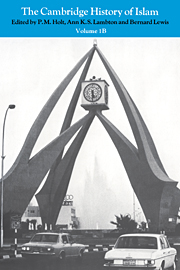Book contents
- Frontmatter
- Introduction
- Part IV The central Islamic lands in recent times
- 1 Modern Turkey
- 2 The Arab lands
- 3 Modern Persia
- 4 Islam in the Soviet Union
- 5 Communism in the central Islamic lands
- 6 The Political impact of the West
- 7 Economic and social change
- Dynastic lists
- Bibliography
- Glossary
- Index
- References
4 - Islam in the Soviet Union
from Part IV - The central Islamic lands in recent times
Published online by Cambridge University Press: 28 March 2008
- Frontmatter
- Introduction
- Part IV The central Islamic lands in recent times
- 1 Modern Turkey
- 2 The Arab lands
- 3 Modern Persia
- 4 Islam in the Soviet Union
- 5 Communism in the central Islamic lands
- 6 The Political impact of the West
- 7 Economic and social change
- Dynastic lists
- Bibliography
- Glossary
- Index
- References
Summary
The Tsarist Russian Empire had the third largest Muslim population in the world, being surpassed only by the British empire, especially India, and the Ottoman empire. After the Orthodox Church, the Muslims were the largest religious group in Russia, with a population of between 15 and 18 millions. This Muslim population was found in all parts of Russia: the Volga-Ural region, Siberia, Central Asia (Turkistān), the Crimea, and the Caucasus. In the main cities of European Russia there had always been large groups of Muslims, especially Kazan Tatars, who, like the people of Āzarbāyjān were advanced materially and culturally, and were to some extent westernized. The Religious Council of the Muslims of Russia in Ufa had been established in 1788 by an edict of Catherine II. The head of this organization, which was attached to the Ministry of the Interior, was a muftī appointed by the Russian government. There also was a board of qādīs. The Kazakh Turks eventually passed under the control of the Religious Council in Ufa in religious and cultural matters. After the Russian occupation and annexation of Turkistān (1865-84), the muftī of Ufa wanted to subject the Muslims in Central Asia to his administration, but the Russian government did not approve of this, and no central religious organization was founded following the annexation of the Crimea, Āzarbāyjān and the northern Caucasus. So, by the time of the Revolution in 1917 the only organization of the Muslims, which was officially recognized and had its expenses paid by the government, was the Religious Council in Ufa.
- Type
- Chapter
- Information
- The Cambridge History of Islam , pp. 627 - 643Publisher: Cambridge University PressPrint publication year: 1977



